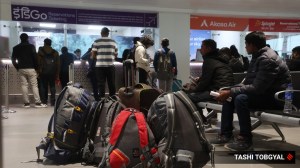In Bengal’s Red Fort, it’s Nirvachan Sadan Zindabad. So?
The silence is almost surreal. It’s Voting Day in the virtual epicentre of Bengal’s Red Fort. But there are no flags, no posters, no party worker hovering around anywhere.

The silence is almost surreal. It’s Voting Day in the virtual epicentre of Bengal’s Red Fort. But there are no flags, no posters, no party worker hovering around anywhere. Bardhaman town (and Katwa too) appear under curfew and the rural stretches in between equally tranquil. The only sign of elections are serpentine queues of men and women outside polling booths, still and silent like wax models.
And when, after voting, some of them do speak up, they can’t stop praising the Election Commission. “Do not ask us who will win—all we know is that this is the best election we have seen,” says Uday Ghoshal, the most vocal of a group of men at Norja More village in the Bhatar Assembly constituency.
A few kilometres down the road, snaking through rippling green and gold paddy fields, the compliments turn more fulsome. Shyamal Santhal, who divulges his name after much prodding by his compatriots in the village chai shop in Mangalkote, refuses to talk about which way the wind is blowing.
“All we can say is Nirbachan Shadan (Election Commission) zindabad. It is ensuring a very peaceful and orderly poll.”
At Ganguldanga village which falls in the Katwa seat, another group of farmers—some of whom confess to being traditional CPI(M) supporters—also speak well of the election process. Since Katwa is one of the few seats in Bardhaman district won by the Congress for two successive terms, they are hoping that a “fair” poll will this time help the CPI(M).
Outside Bhatar High School, where the queue barely inches forward even as the clock approaches the 5 pm deadline, the voters have a different take. ‘‘In our area, the voting percentage is usually between 65 and 70. This time, it may go up to the 90%. Where do you think that extra 20% is going?” they chant in a chorus, none willing to give an answer or his name.
The enigma of this election lies in that question and its imponderable answer: does the quiet, heavy turnout mean that a Left sweep is a foregone conclusion? Or does it signify a silent undercurrent for ‘‘poriborton” (change)?
The CPI(M), usually more cautious than ‘‘bourgeois” parties in predicting poll outcomes, is confident of sweeping Bardhaman yet again. In the 2001 elections, the Left Front won 21 of the 26 seats in the district—losing four seats in the Durgapur-Asansol industrial belt besides Katwa. ‘‘This time our target is to repeat the 1991 result and win all 26 seats,” says Nirupam Sen, once the powerful district secretary of Bardhaman and now widely regarded as Chief Minister Buddhadeb Bhattacharjee’s right-hand man in ushering (as industries minister) the vision of a ‘‘new Bengal.”
Sen, not given to hyperbole, has reasons to be confident. This district, after all, is considered the backbone of the CPI(M).
It is here that a powerful peasant movement first emerged. The Bardhaman District Krishak Samiti, formed in 1933 by communist stalwarts such as Harekrishna Konar, Benoy Choudhury and Sayyad Sahedullah, preceded the formation of the All India Kisan sabha by two years.
It led the movement against the Damodar Canal taxation in the 1930s, laying the base for the Communist Party that has remained largely undented ever since.
Alongside a formidable rural base, the Durgapur-Raniganj-Asansol formed the industrial belt of eastern India since before Independence. Trade unions of coal miners and steel workers provided the communists with the hammer to supplement the sickle, ensuring the signal importance of the district for the CPI(M) politically and organisationally.
In the 1990s, the painful ‘‘de-industrialisation” of West Bengal, with closure of one public sector unit after another, turned parts of Bardhaman into a wasteland. But over the past few years, Sen insists, a kind of resurgence has taken place. There is little hope of reviving central PSUs— the Mining and Machinery Corporation (MAMC), Bharat Opthalmic Glass Limited (BOGL), Hindustand Fertiliser Corporation (HFC), Burns, or the Cycle Corporation of India among several others.
But there have been some positive signs too—the turnaround of the Durgapur Steel Plant, the increasing profits made by Eastern Coalfields Ltd, and promise shown by IISCO. That apart, West Bengal’s new investor-friendly policies have seen around Rs 8000 crore of private sector investment in the iron and steel sector in the Durgapur-Asansol belt.
The discovery of coal-bed methane in the Raniganj area and the development of the service sector—through new satellite townships, educational institutions, and hotel ventures—are the other positives which may help the CPI(M) regain the seats of Asansol, Hirapur, Baraboni and Durgapur-II this time, Sen feels.
As for the rural belt, the new thrust over the last five years on school education, health and rural diversification has more than countered the possibility of an ‘‘anti-incumbency” factor. Going by conventional wisdom and cold logic, therefore, the Left Front should retain its bastion of Bardhaman.
But then elections, like love or loathing, are not always a logical exercise.
If the vague restlessness with the Establishment, discernible in the heart of the Red belt today, is any indication, nothing should be taken for granted by anyone just yet.
- 01
- 02
- 03
- 04
- 05































